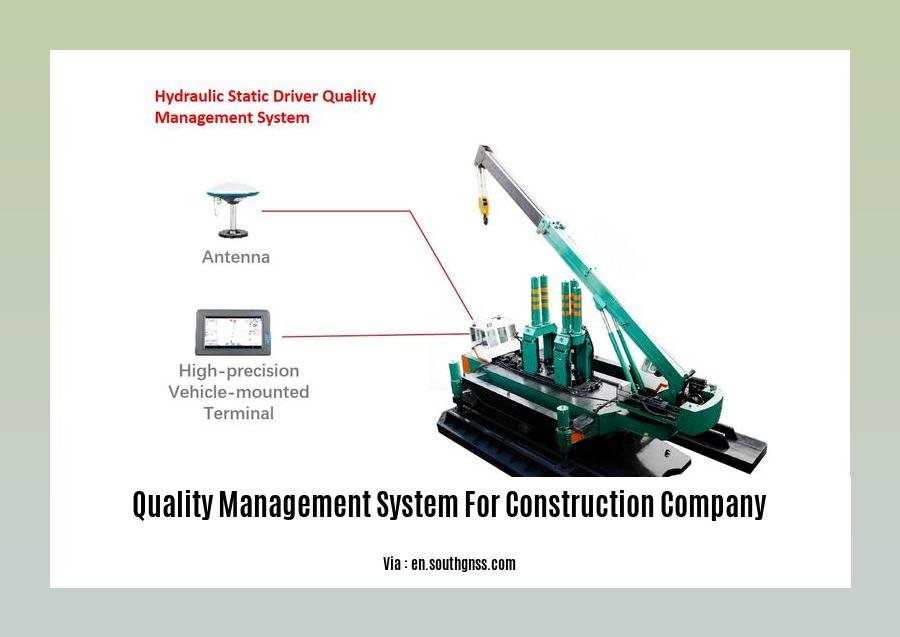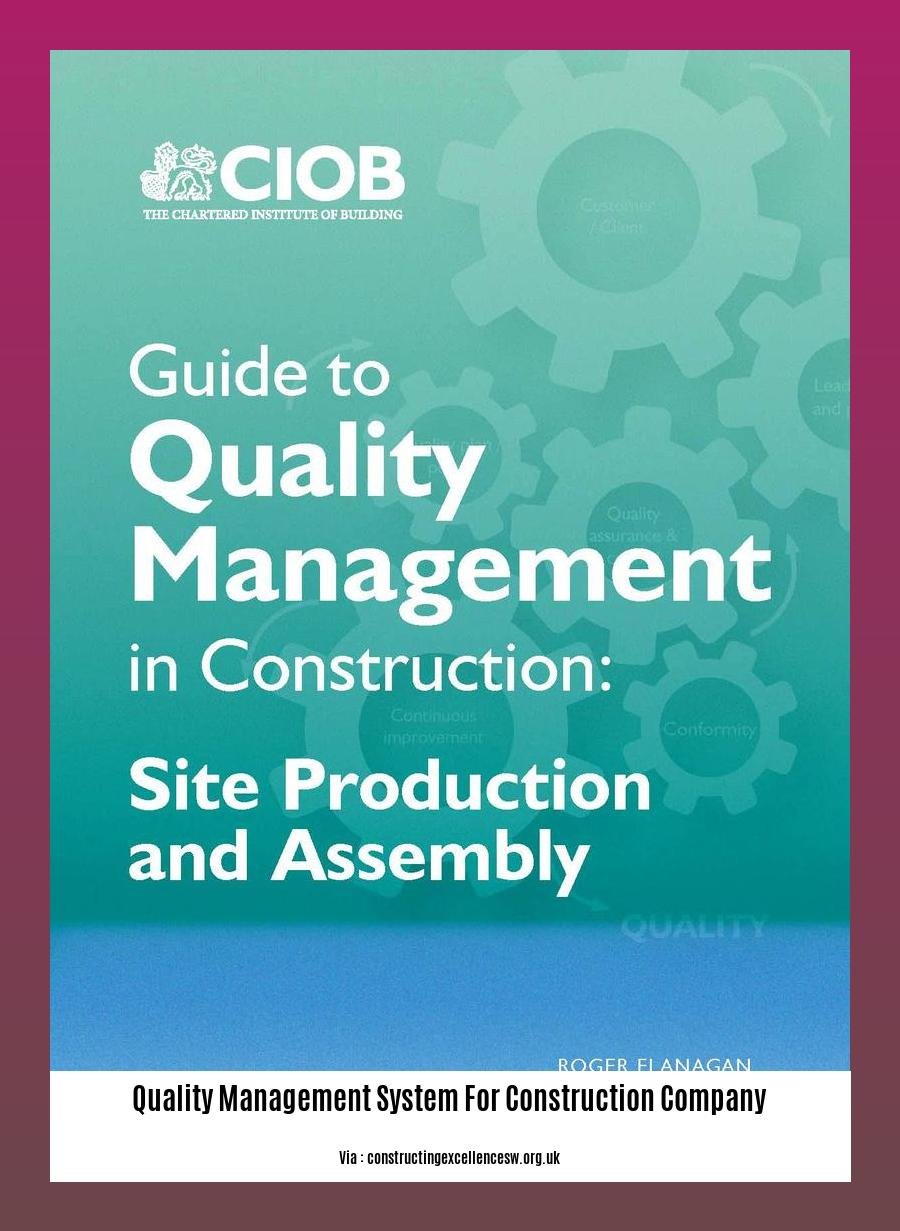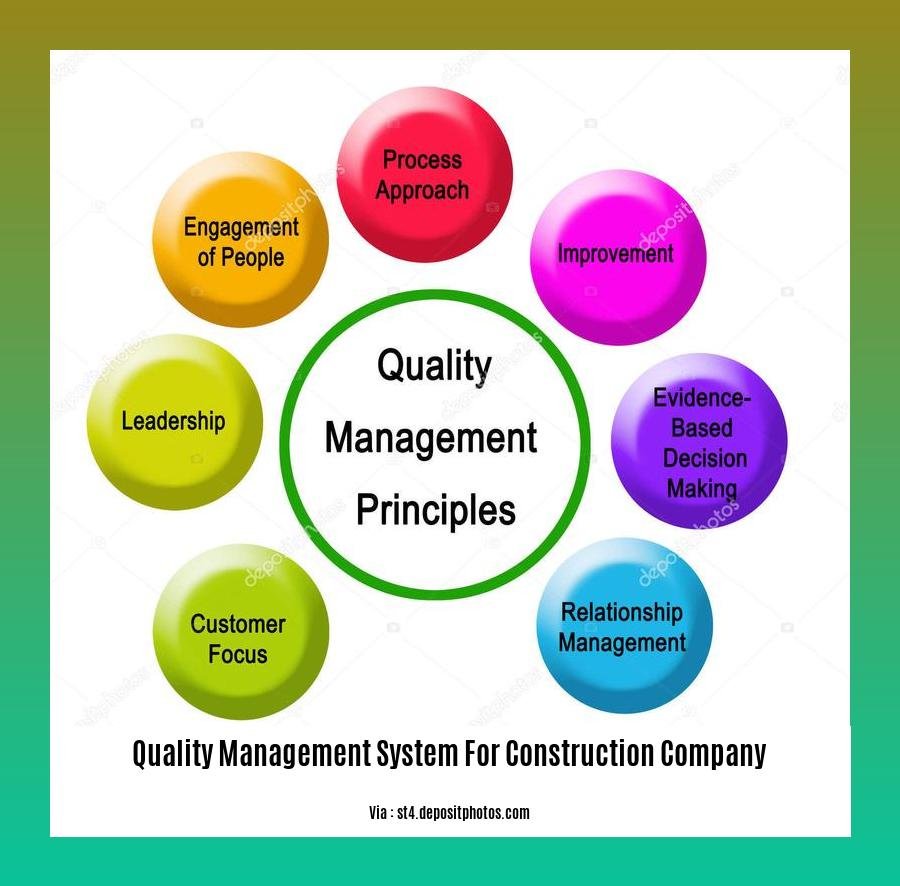Implementing a robust Quality Management System (QMS) is crucial for construction companies seeking to consistently deliver high-quality projects that meet customer expectations. A well-structured QMS provides a comprehensive framework for planning, controlling, and improving processes to achieve optimal construction outcomes. By embracing industry best practices and standards, construction companies can enhance their reputation, minimize risks, reduce rework, and sustain a competitive advantage in a rapidly evolving industry.
Key Takeaways:
- Quality management involves policies and procedures to improve construction quality for clients.
- Quality Management System (QMS) includes planning, assurance, and control.
- Quality Control involves defining criteria, inspecting, correcting deficiencies, and preventing future issues.
- Construction Quality Management controls quality on construction sites.
- Total Quality Management prioritizes continuous improvement.
- Benefits of quality management include customer satisfaction, productivity, reduced rework, enhanced reputation, and profitability.
QUALITY MANAGEMENT System for construction company

A quality management system (QMS) is a set of policies, processes, and procedures that help construction companies deliver quality to their clients. A QMS should be based on the principles of continuous improvement and customer focus.
Key Elements of a QMS for construction company
The key elements of a QMS for construction company include:
- Leadership: Top management must be committed to quality and create a culture of continuous improvement.
- Planning: The company must have a quality plan that outlines its quality goals, policies, and procedures.
- Processes: The company must have documented processes for all its quality-related activities, including design, construction, and customer service.
- Resources: The company must have the resources necessary to implement and maintain its QMS, including personnel, training, and equipment.
- Measurement: The company must measure its quality performance and use this information to improve its QMS.
Types of Quality Management Systems
There are a number of different quality management systems available, including:
- Construction Quality Management: This type of QMS is specifically designed for construction companies. It includes processes for planning, executing, and inspecting construction projects.
- Total Quality Management (TQM): This type of QMS is more holistic and can be used by any type of organization. It includes processes for continuous improvement, customer focus, and employee development.
- Lean management: This type of QMS emphasizes waste reduction and efficiency. It can be used in conjunction with TQM to help construction companies improve their quality and performance.
How to get started
There are a few steps you can take to get started with a QMS for construction company:
- Assess your current state: This is a good time to have outside eyes on your current quality management system if you have one. Determine how effective it is and what changes need to occur. If you don’t have a QMS, understand what processes and systems are in place and how to measure them.
- Develop a quality plan: This plan outlines the company’s quality goals, policies, and procedures.
- Implement the QMS: This is a good time to get the whole team on board. Be sure to have buy-in from all levels to make the transition to the new system successful.
- Train employees: It is important to properly train all employees on the new QMS. This ensures everyone is on the same page and understands the importance of quality.
- Use a QMS software: There are many software programs available that can help you manage your QMS.
Conclusion
A QMS is an essential tool for any construction company that wants to improve its quality and performance. By following the steps, a quality standard can help you get started with a QMS.
- QA QC Construction Job Description provides insights into the responsibilities and qualifications required for this crucial role.
- Discover the comprehensive meaning of QA QC in Construction to understand its significance in ensuring project quality.
- Explore the Qualifications for Construction to gain an understanding of the essential education, experience, and skills needed to succeed in this industry.
- Delve into the concepts of Quality in Building Construction to appreciate the importance of maintaining high standards throughout the construction process.
- Learn about the strategies and techniques involved in Quality Management in Construction Projects to ensure the successful delivery of quality-assured projects.
Inspection and Testing: Establish protocols for regular inspections and testing of materials, components, and systems to verify quality.

Let’s delve into the crucial aspects of inspection and testing in construction quality management.
Material Testing
Material testing is paramount to ensure materials employed in your project align with project specifications and industry standards. This proactive approach reduces the risk of substandard materials jeopardizing the integrity of your construction.
Site Inspections
Regular site inspections are indispensable for verifying compliance with construction methods and ensuring the safety of your construction site. By meticulously monitoring progress, you can proactively identify and address any deviations from established plans, minimizing the likelihood of costly rework or safety hazards.
Steps for Establishing Inspection and Testing Protocols:
- Define Inspection and Testing Objectives: Determine the specific goals and outcomes of your inspection and testing protocols.
- Identify Inspection and Testing Points: Establish a systematic approach to identify the materials, components, and systems to be inspected and tested throughout the construction process.
- Develop Inspection and Testing Methods: Outline detailed procedures for conducting inspections and tests, ensuring consistency and accuracy in data gathering.
- Establish Inspection and Testing Frequency: Determine the appropriate intervals for inspections and tests based on factors such as project complexity and risk assessment.
- Document Inspection and Test Results: Establish a system for recording and documenting inspection and test results, providing auditable evidence of quality assurance.
Key Takeaways:
- Regular inspections and testing: Verify the quality of materials, components, and systems throughout the construction process.
- Material testing: Ensure materials meet specifications and standards.
- Site inspections: Monitor compliance with construction methods and ensure site safety.
- Inspection and testing protocols: Establish consistent and systematic approaches to maintain quality.
Citations:
- Material Testing and Site Inspections: The Foundation of Quality Construction
- QC in Construction: How Builders Manage Quality Control
Corrective and Preventive Action: Develop mechanisms for identifying, investigating, and addressing quality issues proactively.
Imagine yourself navigating a complex construction project, managing a myriad of variables to ensure the highest quality standards. Amidst this intricate web of materials, processes, and people, the ability to effectively identify, investigate, and address quality issues proactively becomes paramount. That’s where Corrective and Preventive Action (CAPA) steps in as your guiding compass.
CAPA is the backbone of a robust quality management system, empowering you with a structured approach to managing quality risks. It’s like having a quality control radar, proactively scanning for potential issues and implementing measures to prevent them from derailing your project.
Here’s how CAPA works:
-
Identify the issue or potential issue: Spotting problems early on is key. Keep your eyes peeled for any deviations from specifications, customer requirements, or industry standards.
-
Investigate and determine the root cause: Dig deep to uncover the underlying reasons behind the issue. This is like solving a construction puzzle, piecing together all the factors that contributed to the problem.
-
Develop and implement corrective or preventive measures: Once you know the root cause, it’s time to take action. Implement corrective measures to fix the immediate issue and preventive measures to stop similar issues from occurring in the future.
-
Monitor and verify the effectiveness of the implemented measures: Don’t just implement and forget. Monitor the effectiveness of your actions and make adjustments as needed. It’s like a quality control feedback loop, ensuring your measures are working as intended.
Key Takeaways:
- CAPA is your proactive shield against quality issues.
- Identifying and addressing issues early on saves time, money, and headaches.
- Understanding the root cause is crucial for effective problem-solving.
- Monitoring and verifying measures ensures continuous improvement.
Additional Resources:
- Pharmaceutical Online: The 10 Phases Of An Effective CAPA
- QualityHub: 10 Tips for Effective CAPA
Performance Measurement and Improvement: Regularly evaluate quality performance and implement continuous improvement initiatives to enhance processes and customer satisfaction.
Monitoring and assessing quality performance are fundamental aspects of construction management. To ensure continuous improvement, construction companies should embrace a systematic approach to performance measurement and improvement. Here are the key elements:
Performance Measurement
- Establish precise performance indicators aligned with quality goals.
- Collect data through surveys, inspections, and customer feedback.
- Analyze data to identify areas requiring attention.
Continuous Improvement
- Define improvement objectives based on performance analysis.
- Implement solutions to address identified issues.
- Monitor progress and adjust strategies to achieve targeted improvements.
By consistently monitoring performance and implementing continuous improvement initiatives, construction companies can enhance quality, drive customer satisfaction, and attain operational excellence.
Key Takeaways:
- Measure quality performance to identify areas for improvement.
- Implement continuous improvement initiatives to enhance processes and customer satisfaction.
- Regularly evaluate and adjust strategies to achieve optimal quality.
Relevant URL Sources:
- Performance Measurement and Improvement in Construction: A Guide for Managers
- Continuous Improvement in Construction: Strategies and Benefits
FAQ
Q1: What are the key elements of an effective quality management system for construction companies?
Q2: How can construction companies implement a quality management system that aligns with industry standards and regulations?
Q3: What are the benefits of implementing a quality management system for construction projects?
Q4: How can construction companies measure the effectiveness of their quality management system and continuously improve their processes?
Q5: What are the challenges and opportunities in implementing a quality management system for construction companies?
- Dark Backsplash Ideas: Drama and Depth for Your Kitchen - November 7, 2025
- Black Backsplash Tile: Find The Perfect Style For Your Kitchen - November 6, 2025
- Black Backsplash With White Cabinets: A Bold Kitchen Design - November 5, 2025










